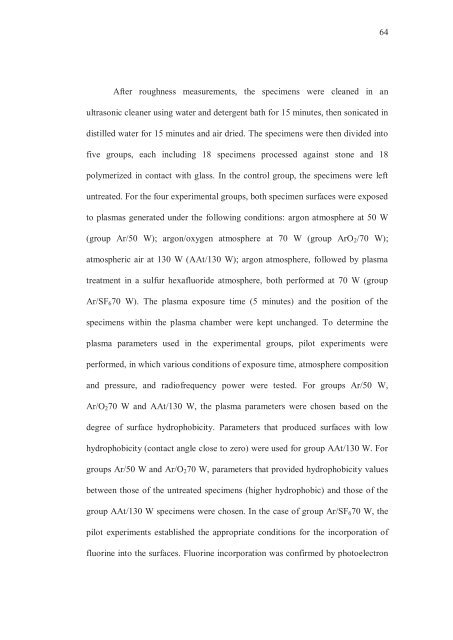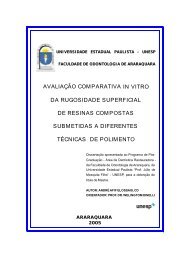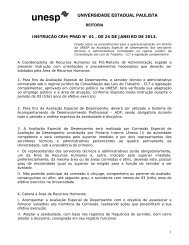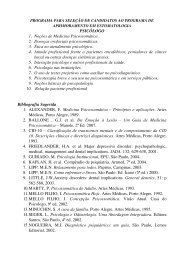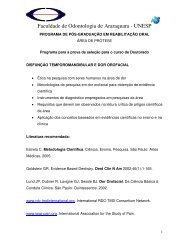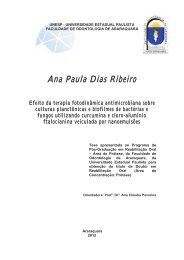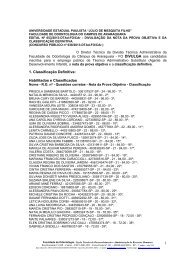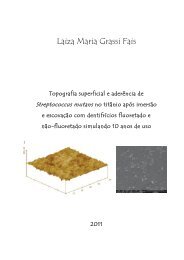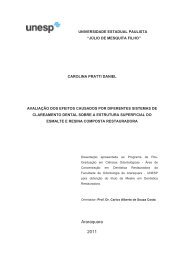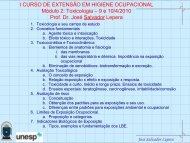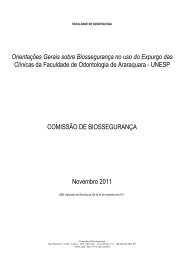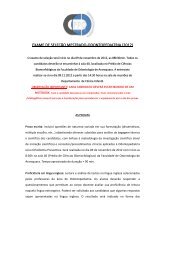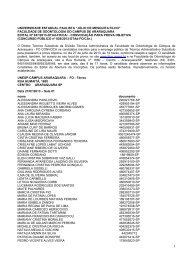universidade de são paulo - Faculdade de Odontologia - Unesp
universidade de são paulo - Faculdade de Odontologia - Unesp
universidade de são paulo - Faculdade de Odontologia - Unesp
You also want an ePaper? Increase the reach of your titles
YUMPU automatically turns print PDFs into web optimized ePapers that Google loves.
64<br />
After roughness measurements, the specimens were cleaned in an<br />
ultrasonic cleaner using water and <strong>de</strong>tergent bath for 15 minutes, then sonicated in<br />
distilled water for 15 minutes and air dried. The specimens were then divi<strong>de</strong>d into<br />
five groups, each including 18 specimens processed against stone and 18<br />
polymerized in contact with glass. In the control group, the specimens were left<br />
untreated. For the four experimental groups, both specimen surfaces were exposed<br />
to plasmas generated un<strong>de</strong>r the following conditions: argon atmosphere at 50 W<br />
(group Ar/50 W); argon/oxygen atmosphere at 70 W (group ArO 2 /70 W);<br />
atmospheric air at 130 W (AAt/130 W); argon atmosphere, followed by plasma<br />
treatment in a sulfur hexafluori<strong>de</strong> atmosphere, both performed at 70 W (group<br />
Ar/SF 6 70 W). The plasma exposure time (5 minutes) and the position of the<br />
specimens within the plasma chamber were kept unchanged. To <strong>de</strong>termine the<br />
plasma parameters used in the experimental groups, pilot experiments were<br />
performed, in which various conditions of exposure time, atmosphere composition<br />
and pressure, and radiofrequency power were tested. For groups Ar/50 W,<br />
Ar/O 2 70 W and AAt/130 W, the plasma parameters were chosen based on the<br />
<strong>de</strong>gree of surface hydrophobicity. Parameters that produced surfaces with low<br />
hydrophobicity (contact angle close to zero) were used for group AAt/130 W. For<br />
groups Ar/50 W and Ar/O 2 70 W, parameters that provi<strong>de</strong>d hydrophobicity values<br />
between those of the untreated specimens (higher hydrophobic) and those of the<br />
group AAt/130 W specimens were chosen. In the case of group Ar/SF 6 70 W, the<br />
pilot experiments established the appropriate conditions for the incorporation of<br />
fluorine into the surfaces. Fluorine incorporation was confirmed by photoelectron


